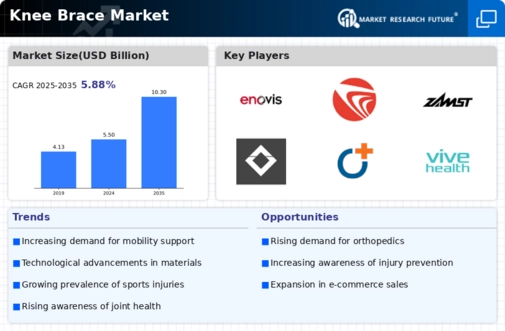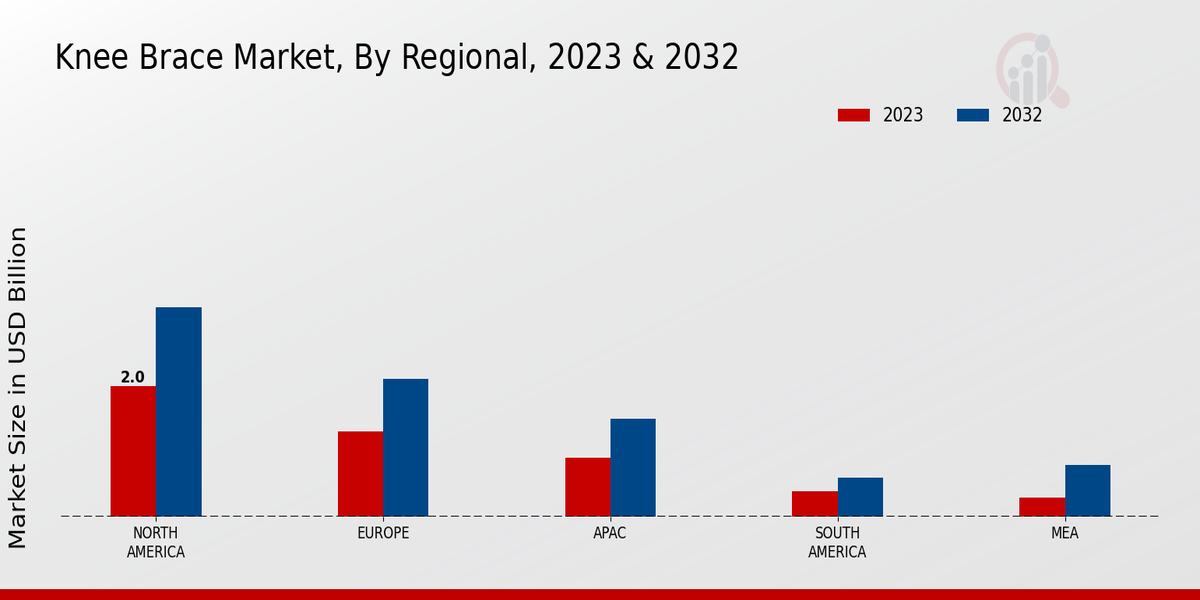Market Growth Projections
The Global Knee Brace Market Industry is poised for substantial growth, with projections indicating a market value of 5.5 USD Billion in 2024 and an anticipated increase to 10.3 USD Billion by 2035. This growth is underpinned by a compound annual growth rate (CAGR) of 5.87% from 2025 to 2035. Such figures suggest a robust demand for knee braces driven by factors like rising injury rates, technological advancements, and an aging population. The market's expansion reflects a broader trend towards health and wellness, as consumers increasingly prioritize preventive measures and effective treatment options for knee-related issues.
Increase in Sports Participation
The surge in sports participation globally is a significant factor propelling the Global Knee Brace Market Industry. As more individuals engage in various sports, the likelihood of knee injuries rises, thereby increasing the demand for protective gear such as knee braces. According to health organizations, participation in sports has been linked to a higher incidence of knee-related injuries, particularly among youth and amateur athletes. This trend suggests that the market will continue to grow, as consumers seek effective solutions to safeguard their health. The projected market value of 5.5 USD Billion in 2024 reflects this increasing demand.
Rising Incidence of Knee Injuries
The increasing prevalence of knee injuries globally is a primary driver of the Global Knee Brace Market Industry. Factors such as sports participation and an aging population contribute to this trend. For instance, the World Health Organization indicates that knee injuries are among the most common musculoskeletal injuries, leading to a growing demand for knee braces. In 2024, the market is projected to reach 5.5 USD Billion, reflecting the urgent need for effective support solutions. As awareness of injury prevention rises, the market is likely to expand further, indicating a potential for sustained growth in the coming years.
Technological Advancements in Knee Braces
Innovations in knee brace technology significantly influence the Global Knee Brace Market Industry. The development of smart knee braces equipped with sensors and adjustable features enhances user experience and treatment outcomes. These advancements allow for personalized support, which is particularly appealing to athletes and individuals recovering from surgery. As the market evolves, the integration of materials that provide better comfort and durability is becoming more prevalent. This trend suggests that the market could experience substantial growth, potentially reaching 10.3 USD Billion by 2035, as consumers increasingly seek high-quality, technologically advanced products.
Growing Awareness of Preventive Healthcare
The rising awareness of preventive healthcare measures is driving demand within the Global Knee Brace Market Industry. Individuals are becoming more proactive about their health, leading to increased interest in products that can prevent injuries. Educational campaigns and health initiatives promote the use of knee braces not only for rehabilitation but also for injury prevention during physical activities. This shift in consumer behavior indicates a potential for market expansion, as more people recognize the benefits of knee braces. The anticipated CAGR of 5.87% from 2025 to 2035 further underscores the growing importance of preventive healthcare in shaping market dynamics.
Aging Population and Osteoarthritis Prevalence
The aging population worldwide is a critical driver of the Global Knee Brace Market Industry. As individuals age, the prevalence of osteoarthritis and other degenerative knee conditions increases, necessitating the use of supportive devices like knee braces. The World Health Organization reports that osteoarthritis affects millions of older adults, leading to a heightened demand for knee braces that provide relief and support. This demographic trend suggests a sustained market growth trajectory, with projections indicating a market value of 10.3 USD Billion by 2035. The increasing need for effective management of knee-related issues among the elderly population is likely to shape market dynamics.











